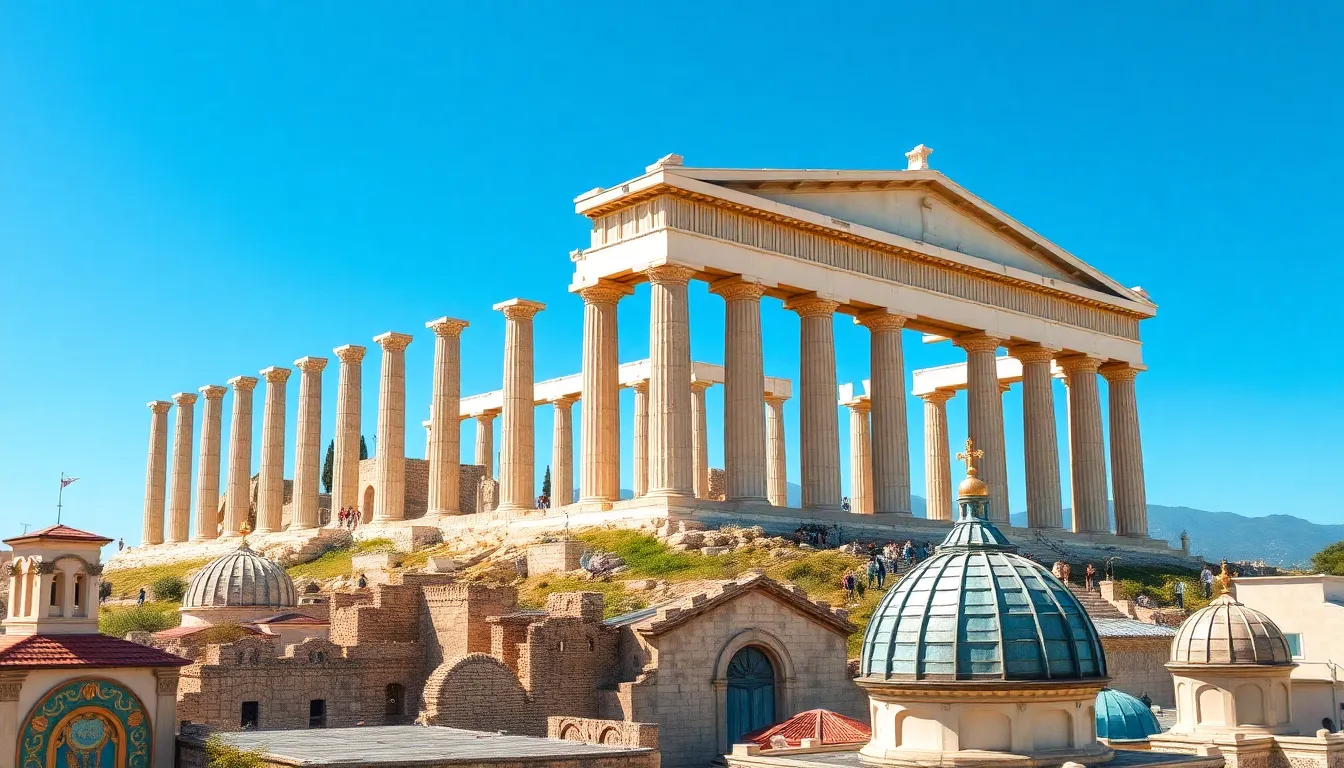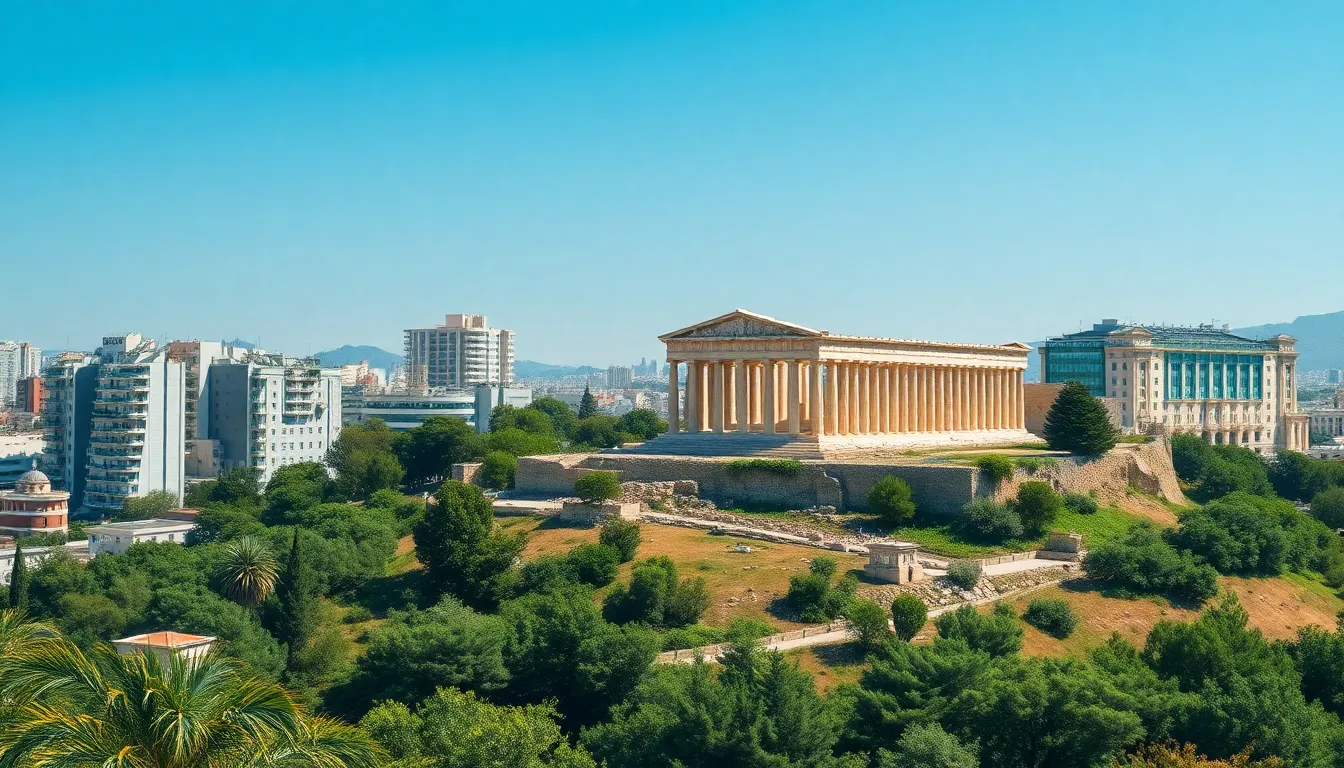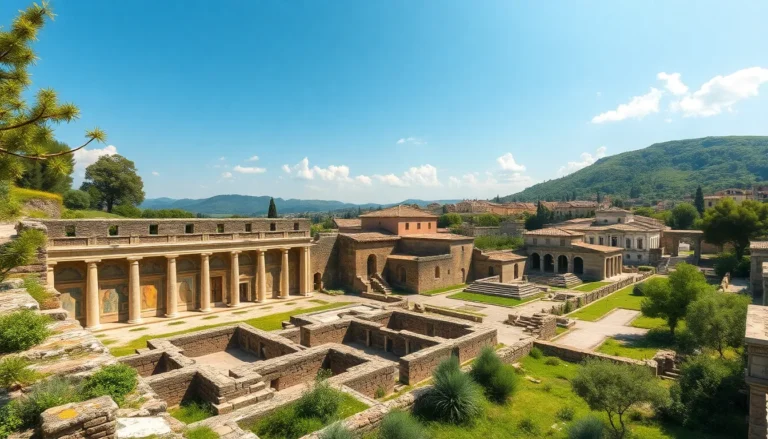Athens isn’t just the cradle of democracy; it’s also a playground for architecture enthusiasts. With its stunning blend of ancient ruins and modern marvels, the city offers a visual feast that’s hard to resist. Imagine strolling through the streets where the Parthenon stands tall, whispering tales of gods and philosophers, while sleek contemporary buildings pop up like mushrooms after a rainstorm.
Table of Contents
ToggleOverview of Athens Architecture
Athens architecture features a remarkable blend of ancient and modern styles, reflecting the city’s rich history and contemporary spirit. In this urban landscape, iconic historical structures coexist with innovative modern designs.
Ancient Architecture
Ancient architecture in Athens showcases classical Greek elements, prominently displayed in structures like the Parthenon and the Temple of Olympian Zeus. These monuments exhibit Doric and Ionic columns and intricate sculptures, highlighting the artistry of ancient builders. The Agora, once the heart of Athenian public life, also signifies the architectural prowess of the era.
Neoclassical Period
The Neoclassical period introduced a revival of ancient Greek styles. Notable examples include the Academy of Athens and the National Library, both designed by architect Theophil Hansen in the 19th century. These buildings feature grand facades, symmetrical proportions, and decorative elements, illustrating the influence of classical architecture on modern design.
Modern Architecture
Modern architecture in Athens reflects innovation and functionality. Structures such as the Stavros Niarchos Foundation Cultural Center and the Athens Concert Hall highlight contemporary design principles. These buildings prioritize sustainability, open spaces, and integration with their surroundings, demonstrating Athens’s commitment to architectural progress.
Urban Integration
Athens’s urban integration serves to connect historical sites with modern developments. The pedestrianization of the area surrounding the Acropolis enhances accessibility and encourages exploration. Urban planning initiatives aim to preserve historical integrity while promoting contemporary architectural advancements.
Conclusion
Athens architecture offers a diverse range of styles, showcasing the city’s legacy and future aspirations. Visitors encounter a unique visual journey, experiencing the harmonious balance between ancient grandeur and modern creativity throughout the city.
Historical Influences on Athens Architecture

Athens architecture showcases a blend of historical influences, with each era contributing unique elements that shape the city’s design.
Ancient Greek Contributions
Ancient Greece laid the foundation for Athenian architecture through its iconic Doric, Ionic, and Corinthian orders. Structures like the Parthenon illustrate these classical styles, emphasizing symmetry, proportion, and the use of columns. Temples dedicated to the gods, such as the Temple of Hephaestus, highlighted religious practices and community values. The architectural principles established during this period resonate in modern designs, influencing both local and global architecture.
Byzantine Era Influences
The Byzantine era introduced intricate designs and artistic ornamentation to Athens architecture. Churches, such as the Church of the Holy Apostles, featured domed roofs and mosaics, showcasing a departure from classical styles. This period emphasized the use of brick and colorful decorative elements, reflecting spiritual themes and local customs. The fusion of Greek and Eastern influences during this time established a unique architectural language that still resonates in the city’s landscape today.
Modern Architectural Developments
Athens showcases a dynamic architectural landscape that integrates modernity with a rich historical context. Key developments highlight the city’s evolution and forward-thinking approach.
Neoclassical Elements
Neoclassical architecture in Athens, reflecting the revival of classical ideals, appears in several key structures. The Academy of Athens and the National Library illustrate this style’s emphasis on symmetry, grandeur, and the use of columns. These buildings serve as cultural landmarks, combining aesthetic beauty with functional purpose. Their intricate facades, adorned with sculptures and decorative motifs, demonstrate the commitment to uphold classical principles while adapting to the modern urban environment.
Contemporary Architectural Trends
Contemporary architecture in Athens emphasizes sustainability and innovative design. The Stavros Niarchos Foundation Cultural Center exemplifies this trend, featuring eco-friendly materials and green spaces. This facility integrates cultural and recreational purposes while enhancing its surroundings. Other examples include the Athens Concert Hall, which showcases cutting-edge design elements and functionality. These modern structures prioritize accessibility and community engagement, reflecting Athens’ commitment to fostering a vibrant urban life that respects its rich historical narrative.
Iconic Structures in Athens
Athens features a wealth of iconic structures, each reflecting the city’s rich architectural heritage.
The Acropolis
The Acropolis stands as a symbol of ancient Greece, representing the pinnacle of classical architecture. This ancient citadel, perched atop a rocky outcrop, includes several significant structures, notably the Parthenon. Built in the 5th century BC, the Acropolis displays Doric and Ionic architectural styles, characterized by grand columns and intricate sculptures. Its strategic location not only emphasizes its historical importance but also offers panoramic views of Athens. Every year, millions visit the Acropolis to appreciate its artistic beauty and historical significance, reinforcing its status as a UNESCO World Heritage Site.
The Parthenon
The Parthenon, dedicated to the goddess Athena, epitomizes ancient Greek architecture. Constructed between 447 and 432 BC, this former temple showcases the Doric order’s defining characteristics, including its distinctive columns and harmonious proportions. The Parthenon features elaborate sculptures, including the renowned frieze and the statue of Athena Parthenos, created by Phidias. This masterpiece represents the epitome of classical design, combining beauty and functionality. Despite enduring centuries of damage, restoration efforts continue, preserving this architectural gem for future generations. Its enduring presence makes the Parthenon a vital part of Athens’ cultural and historical identity.
Preservation and Restoration Efforts
Preservation and restoration efforts in Athens play a crucial role in maintaining its architectural heritage. Organizations like the Acropolis Restoration Project focus on conserving the Acropolis and its structures, ensuring they withstand the elements and human impact. These initiatives involve meticulous research and craftsmanship to restore damaged features while remaining true to historical accuracy.
Restoration of ancient structures often uses traditional methods and materials to retain authenticity. Examples include the Parthenon, where ongoing restoration aims to repair damage from pollution, earthquakes, and previous restoration efforts. Experts collaborate to analyze and select suitable stones, ensuring that repairs match the original design and construction techniques.
Public awareness campaigns enhance appreciation for Athens’ architectural significance. Educating residents and visitors through workshops, exhibitions, and guided tours fosters community involvement in preservation projects. Engaging local stakeholders plays a crucial role in securing funding and resources necessary for continued restoration efforts.
Sustainable practices in preservation are increasingly emphasized. The integration of eco-friendly materials and techniques enhances the longevity of restored structures. For instance, the Stavros Niarchos Foundation Cultural Center not only preserves modern architectural integrity but also emphasizes environmental responsibility through its design.
Collaboration between government agencies, cultural institutions, and academic entities supports comprehensive preservation strategies. This partnerships maximize resources and expertise, ensuring that Athens’ architectural legacy remains a focal point for future generations. Regular monitoring and assessment of historical sites provide ongoing insights into necessary interventions, maintaining their integrity over time.
Through these preservation and restoration efforts, Athens celebrates its unique architectural tapestry. These initiatives preserve the historical narrative while promoting a harmonious relationship between the ancient and modern environments.
Athens stands as a testament to the enduring dialogue between its ancient roots and contemporary aspirations. The city’s architectural landscape invites exploration and admiration, revealing layers of history that shape its identity. Visitors can immerse themselves in the grandeur of the Parthenon while also appreciating the innovative spirit of modern designs.
Efforts to preserve and restore Athens’ architectural gems ensure that future generations will continue to experience this unique blend of past and present. As the city evolves, it remains committed to honoring its rich heritage while embracing sustainable practices that enhance urban life. Athens architecture is not just a visual feast; it’s a narrative that speaks to the resilience and creativity of its people.




